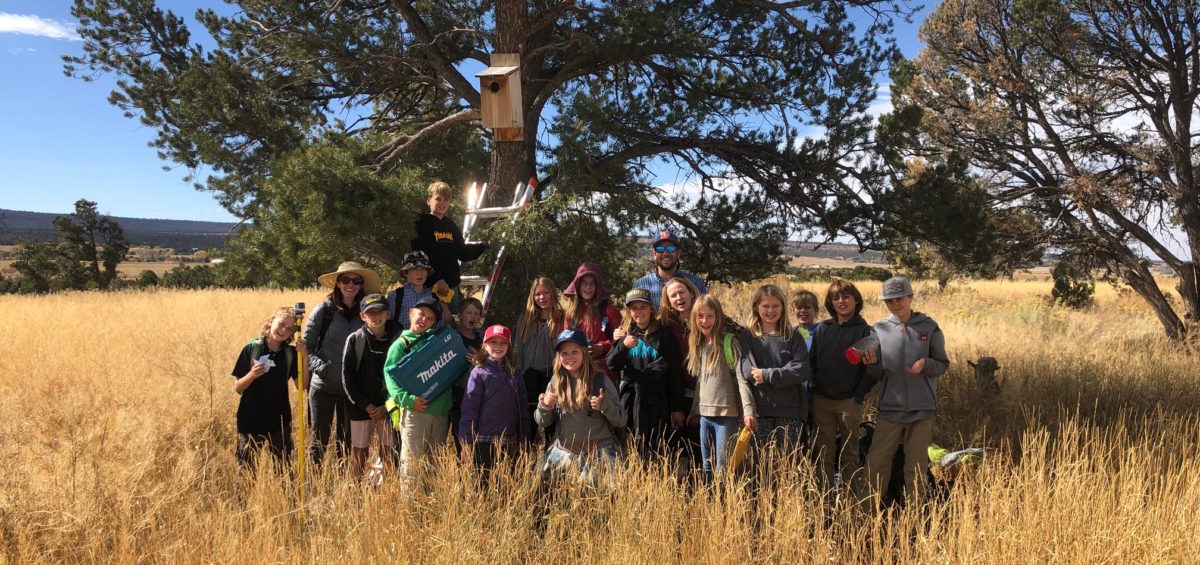A group of fifth- and sixth-grade students from the Telluride Mountain School (TMS) received unanimous approval two years ago from the Telluride Open Space Commission to construct and place five nesting-boxes across the Valley Floor to collect data about the American kestrel, a long-tailed falcon whose population has been steadily declining since the 1960s.
TMS sixth-grader Gus Markley, has developed a keen eye in identifying kestrels, along with his classmates.
“They’re the smallest bird of prey,” he says. “Males have bluish wings, and females are bigger with a chubby head. They can hover like a helicopter, which is an easy way to spot them.”
Since the nesting boxes were installed on the Valley Floor, students have monitored kestrel activity and forwarded the data collected to the American Kestrel Partnership (AKP), an Idaho-based organization that consists of more than 600 partners who track similar data.
“The whole goal of the AKP is to connect citizen scientists with research scientists in order to understand why kestrel populations are declining across the US,” explained Ben Gardner, the TMS lower school science teacher leading the project. “And so as citizen scientists, the students lead this whole project.”
Students have held two Skype conversations in recent weeks with AKP Director Sarah Schulwitz.
“It was cool Skyping with Sarah. We asked her questions and discussed our hypotheses for why kestrels are declining,” sixth-grader Lyssa Neuman said. “I was surprised to learn that the kestrels aren’t endangered. We’re always talking about how their population is declining, so I just assumed they were on the endangered species list.”
While they haven’t discovered kestrels actually nesting in the boxes yet, students have spotted kestrels in the Town of Telluride and there have been sightings uploaded to eBird, a popular birding website that has aided the research process.
“Where the highlight around the research project for the first group of students was the civic discourse with commissioners, this year it’s about conservation and meeting landowners and talking about how other people in the communities surrounding Telluride can be involved,” Gardner explained.
The original plan was to leave the nesting boxes on the Valley Floor, which is easy for TMS students to access as an outdoor classroom. Via eBird, students learned that there are more kestrels living in Norwood, so they decided to place additional nesting boxes out there; an unexpected turn in the course of the research project
“Kestrels might go to Norwood because they have to fly over the canyon to get to Telluride,” Neumann said. “And there’s more food out there.”
“Telluride isn’t really a good place for kestrels because it’s not in a migratory path,” Markley added. “And Norwood is a much more open place.”
The students wrote a pitch script in class, and for their final unit assessment, each student developed a persuasive kestrel slide show and PowerPoint presentation. Half the students were responsible for calling various Norwood landowners to gage interest in installing a nesting box on their properties and undertaking regular monitoring of kestrels. Students who submitted high quality presentations on time were selected to lead the in-person presentations.
Last week, all 17 TMS fifth- and sixth-graders traveled to the homes of Marie and Johnny Green, Eric Watkins, and Ryan Howe in Norwood and the student-presenters walked each property owner through a presentation.
“We hung up the box and showed them how it works: how to open it and put in the camera so you can see all the kestrels,” sixth-grader James Welch said. “And then three of us presented to the landowners, addressing what kestrels do, what they eat, what they look like, where they live, where they go for winter migration and current research on why they’re declining in population.
“I enjoyed teaching an older person. You’d see them paying attention, focusing on the computer, at the slides and getting the information that they needed to know.”
“Since James and I really like this project, it wasn’t as hard as it could have been,” Markley added. “I knew a lot about kestrels so instead of just looking down at my presentation, I could speak from my head.”
While a central goal of this science unit is for students to understand more about habitats, populations and extinctions, it’s also meant to allow students to mimic a real scientist’s job.
“I hope it ignites that spark for students to be focused on science and want to be scientists,” Gardner said.
~Amy Peters
Planet Contributor





Leave a Comment